The #10276 LEGO Creator Expert Colosseum was released on Black Friday weekend, and this set is definitely worth talking about. It features a spectacular replica of the Colosseum in Rome and with 9,036 pieces, it’s also the biggest LEGO set of all time in terms of piece-count. So, let’s take a closer look at this masterpiece.
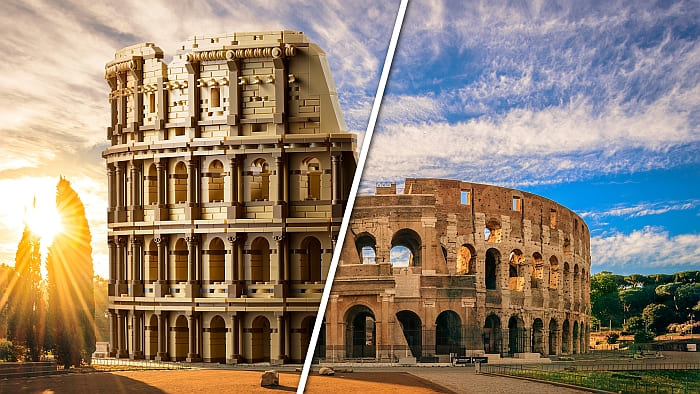
LEGO COLOSSEUM – THE PACKAGING: While LEGO packaging is usually pretty simple and straightforward, some of the largest and most impressive LEGO sets have equally impressive packaging. The Colosseum comes in a massive box with four smaller boxes inside to help distribute the weight of the parts. All of the boxes are black and feature images of the Colosseum (the interior boxes depict the section of the Colosseum you will be working on). The classy packaging reminds you that you will be building something truly spectacular.
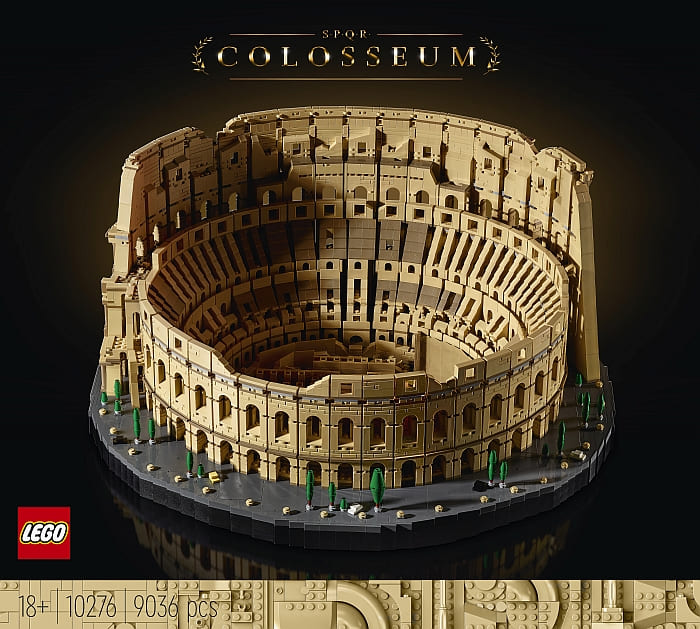
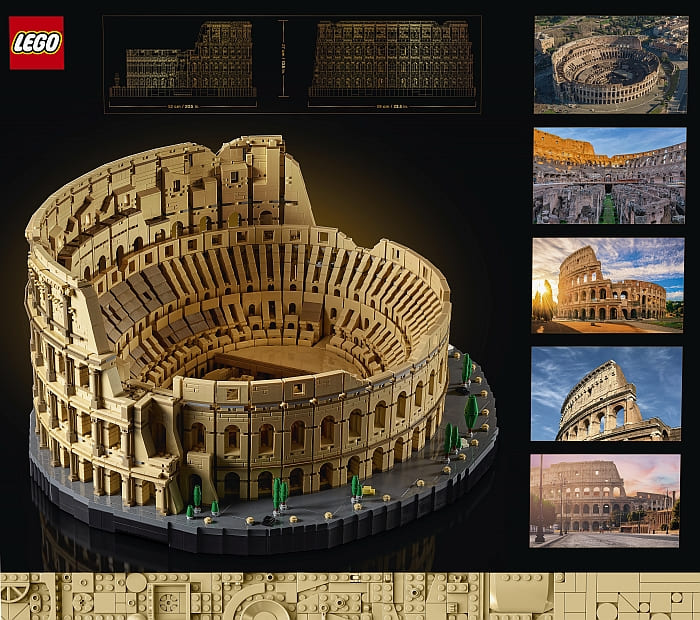
LEGO COLOSSEUM – THE INSTRUCTIONS: The set comes with four instruction booklets. The first seven pages of each of the booklets feature beautiful images, historical details, and interesting facts about the real life Colosseum and its construction. These historical tidbits are some of my favorite parts of the set. They help you connect with the project even if you’re not fully familiar with it.

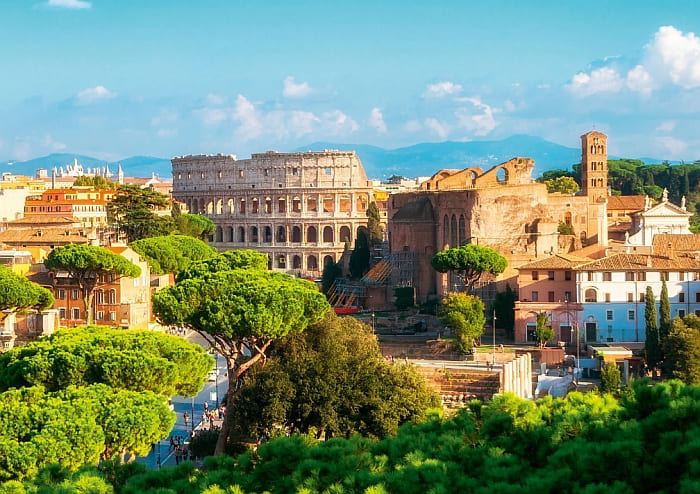

LEGO COLOSSEUM – THE PARTS: As mentioned above, the set comes with 9,036 pieces. They are divided into bags 1-68, and there are also some unnumbered bags with larger parts. The symmetrical nature and the mostly monotone color scheme of this set mean that you will get a relatively small number of different parts, but many of them in very large numbers. The fairly simple building techniques also mean that most of the parts are basic bricks, plates, and tiles. To give you an idea here are some examples; 364 tan 1×1 round plates, 148 tan 1×1 plates, 114 tan 1×1 cheese-slopes, 613 tan 1×1 bricks, 293 tan 1×2 bricks, 207 tan 1×2 masonry bricks, 92 tan 1×4 masonry bricks, 304 tan 1×2 plates, 249 tan 1×2 slopes, 340 tan 1×3 arches, 236 tan 1×4 arches, 10 of those large 16-x16 LEGO Technic bricks that were introduced with the LEGO Art collection in black (this time they are olive-green and create the base of the structure), 237 dark-tan 1×2 jumper-plates, and 213 dark-tan 1×2 modified plates with rail. There are no new parts in the set, although there are some recolors. If you’re looking for basic parts in large quantities, this set is a goldmine.

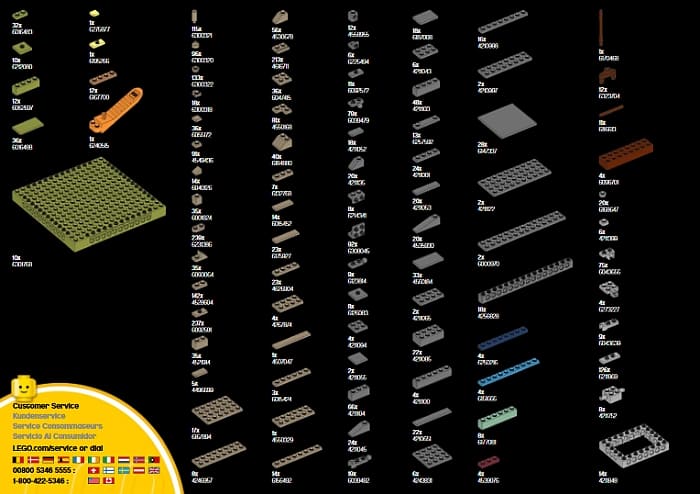
LEGO COLOSSEUM – THE COLORS: The two main colors of the Colosseum itself are tan and dark-tan, and the base is black and dark-gray. The center of the Colosseum is olive-green. These colors come together nicely in the final build and look realistic. However, the inside structure of the Colosseum is quite colorful with some blue, red, yellow, white, and green pieces. They help break up the monotony and also assist with the placement of the parts in the early stages of the construction.

LEGO COLOSSEUM – THE BUILDING EXPERIENCE: As you probably guessed by now, building the Colosseum is full of repetitive steps. You will be assembling the same or very similar sections over and over again from over 9,000 pieces. The fact that you are using mostly just one color makes this even worse. There are some subtle variations, which will make the finished structure more realistic as an ancient ruin, but there is no way around the repetitive nature of the build. After all, you’re building a huge oval building with repeating elements.

Building the Colosseum is closer to putting together one of those giant family-size jigsaw puzzles than a traditional LEGO set. In fact, if you want to set yourself up for a pleasant building experience, it’s best to think of the Colosseum as a three-dimensional jigsaw puzzle. Spread out the building process into small chunks that you assemble over a longer period of time – like several days or even weeks. This way, you won’t get frustrated by the repetitiveness of the building steps. If you surrender to the idea that building this set is going to be a long and tedious journey, you will be able to relax into the process and enjoy the experience. It’s like an exercise in mindfulness.

And, if you don’t like jigsaw puzzles and other similar activities that take a long time, you may decide that this set is not for you. It’s better to realize that now than after you spend a boatload of cash for a LEGO set that you won’t enjoy. There are plenty of other LEGO sets that provide a shorter and/or more interesting building experience.
LEGO COLOSSEUM – THE ARCHITECTURE: The LEGO Colosseum is a fantastic example of how real-life architecture can be translated into LEGO. This includes sizing, choices for colors, choices for architectural elements, where to stay true to the source material, and where (if and when necessary) to compromise.
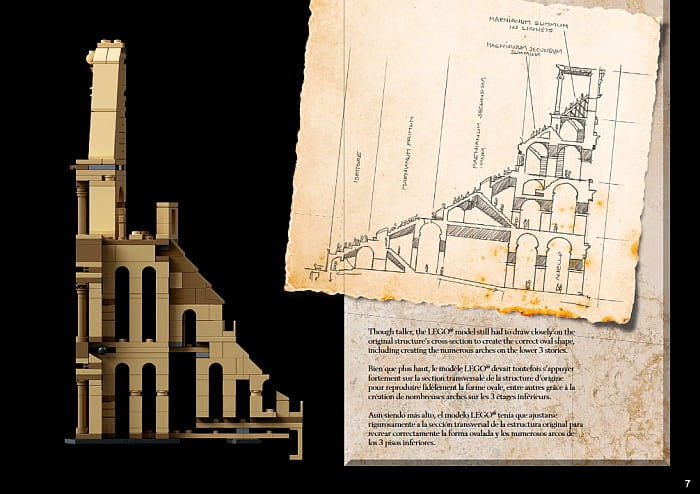
The shape and size of LEGO elements usually dictate the size of the model. As arches are crucial for recreating the Colosseum, currently available arch elements were some of the most important deciding factors. These arch elements also caused limitations, which is why the LEGO Colosseum ends up being taller than the real Colosseum and the arches appear narrower.
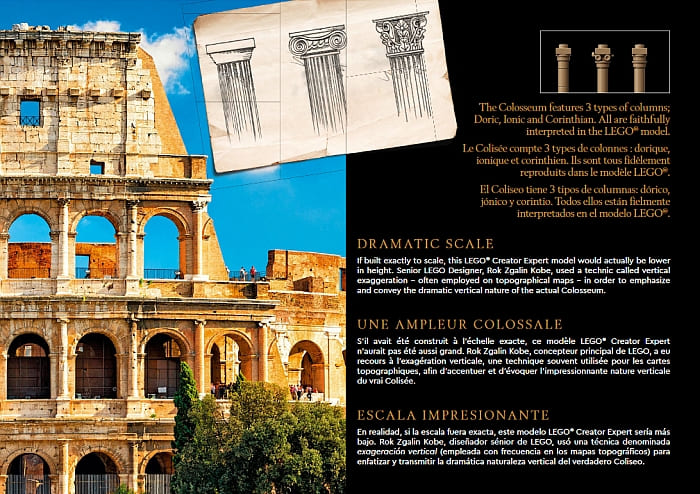
Another good example where we can observe how LEGO designers worked with the strengths and limitations of LEGO elements is with the construction of the columns. The real Colosseum uses three types of columns – Doric, Ionic, and Corinthian – each style progressively more fancy. The Doric column is represented well in the LEGO Colosseum, and the Ionic column is also reasonably well done with dark-tan skateboard elements. However, the Corinthian column ends up being too simple, almost the same as the Doric column. Perhaps these columns could have been fancied up a bit with some modified 1×1 round plates, but the bottom line is that observing how LEGO designers handle challenges is a valuable study in itself.
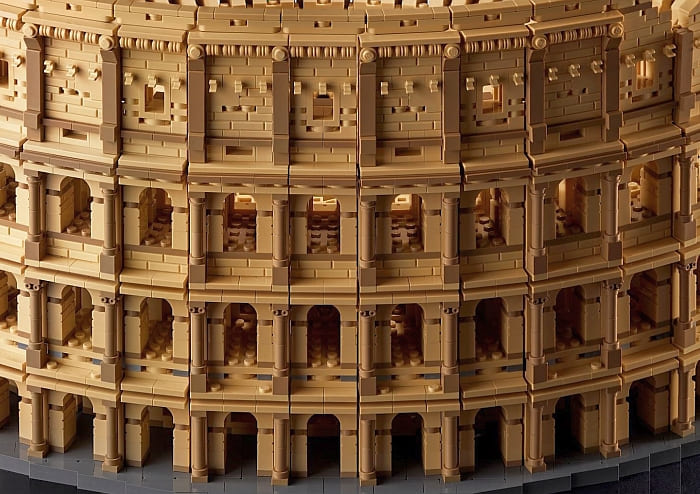
One of the most interesting sections of the Colosseum is the center stage and the underground system of rooms and passageways below it where gladiators and animals were kept as well as mechanisms to support the various stage activities. According to Wikipedia, this complex underground system was built later. Before that, the center stage was simpler, and could even get flooded with water to use for mock sea battles! LEGO designers did an excellent job with this section making it a truly interesting building experience and conversation piece.

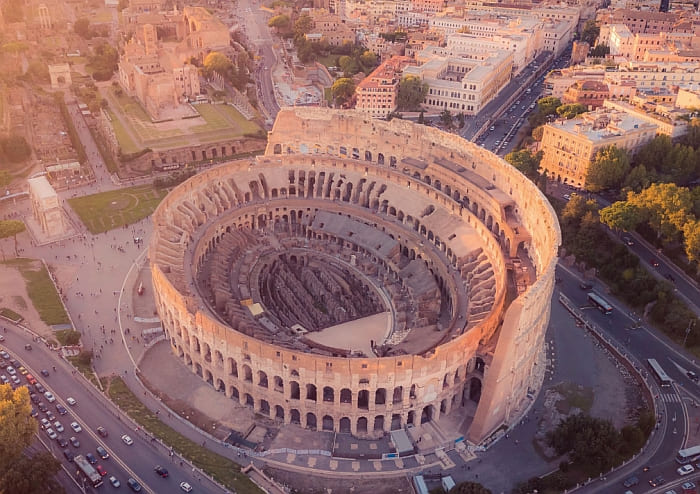
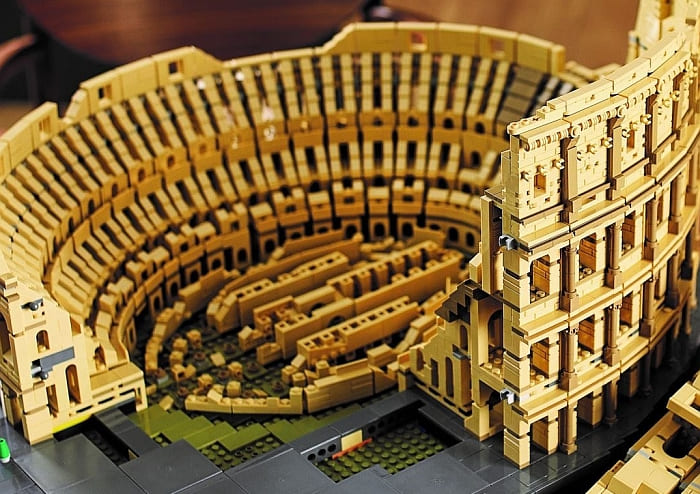

LEGO COLOSSEUM – THE DISPLAYABILITY: The LEGO Colosseum is an impressive display piece for sure. It is instantly recognizable and looks beautiful from every angle. It would be perfect for a school, library or similar institution. But it may not be suitable for every home. For once, it has a huge footprint. It measures around 10.5” (27cm) high, 20.5” (52cm) wide, and 23.5” (59cm) deep. To compare, the #75192 LEGO Star Wars Millennium Falcon – which is still the largest set by size – measures around 8” (21cm) high, 33” (84cm) long, and 22” (56cm) wide. Neither set can be displayed on a standard shelf. They need their own display area, like a dedicated table, or specialty display case. Secondly, the set has little play-value, unlike the Millennium Falcon which has some interactive features and playability. This means that once you build it, it will simply take up space. Consider these points carefully when thinking about purchasing the set.
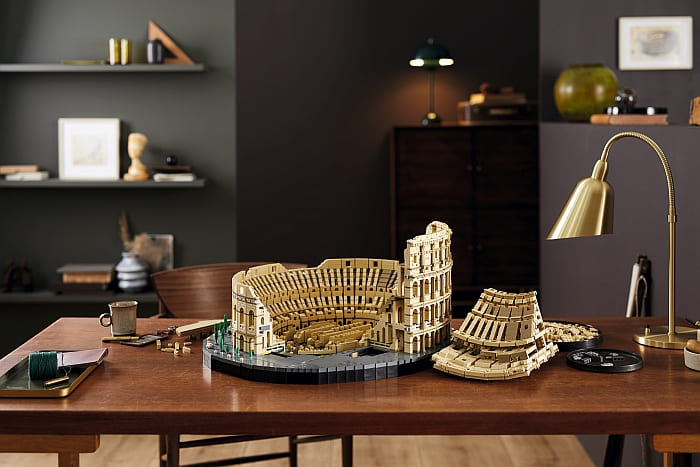
LEGO COLOSSEUM – THE VALUE: The price of the #10276 LEGO Creator Expert Colosseum is excellent. 9,036 pieces for $550 means it’s only 6 cents per piece. And we are not just talking about tiny pieces. There are hundreds of useful larger elements in some of the most versatile and desirable colors. The monotone color scheme also makes this an excellent set for parting out and using it for other large projects. So, it’s perfectly reasonable to consider buying this set just for the parts. If you are interested, it’s available at the LEGO Creator Expert section of the Online LEGO Shop.
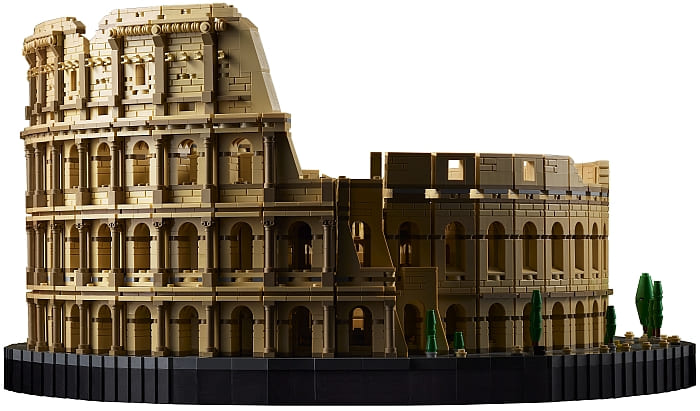
LEGO COLOSSEUM – SUMMARY: The #10276 LEGO Creator Expert Colosseum is a beautiful example of what can be achieved with LEGO. If you love ancient history, architecture, building large and intricate models, or have a large empty space that is just begging for something impressive, the LEGO Colosseum is an excellent candidate. And even if you don’t care for any of the above, but you have a need for a number of useful parts in neutral colors, you may find it interesting as well. Now the question is what LEGO set will break the 10,000-piece barrier?
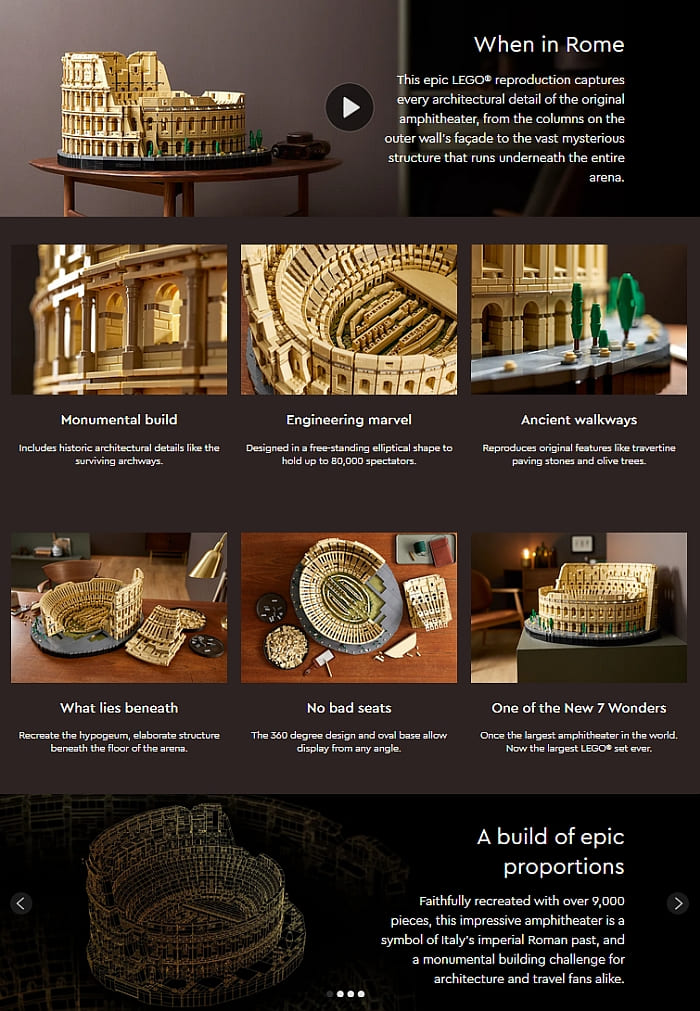
What do you think? How do you like the LEGO Colosseum? Is this a set you consider getting? Or did you get it already? How do you like the size, the architecture, and architectural details? Feel free to share your thoughts and own reviews in the comment section below!
And you might also like to check out the following related posts:












Thanks for posting about this. It’s one of those sets I would love to build, but I don’t know what I would do with it afterward.
I love that they included so much info about the colosseum. This would be a great set to build with a bunch of history students..
Not a set I would buy, but I’m impressed by how accurate it looks.
I wonder who is the target market for these sets. They are clearly selling enough of them to keep making large landmarks like this. But I always wondered why people buy them and where do they put them.
How long does it take to build it? Just wondering
What I have seen, most people spread it out for several days. Based on the piece count, my guess is that in one sitting it would take something like 19 hours.
Yes, that sounds about right. It’s a very long build.
If you do it in one sitting, I’m sure you will see actual Romans passing by to talk to you…
Well, too little colors, no minifigs, not enough space in my city apartment, repetitive, tedious building process and (in my opinion) too expensive for what you get. Clearly not for me…
I have the Colosseum set and have put it together over the last three months. Ran into some structural issues when I got onto the higher side (with the arcade and the outer wall combined). Think I’ve come up with a solution but looking for a sanity check.
Not going into all the details in case this website is no longer in use. Would appreciate a response back if you’re still there. Many thanks.
Tad, we’re here, so go ahead and share! 🙂
Many thx for getting back at me. I really hope you understand all of my descriptions. I can do a video if that will help.
My problem: When you get onto the side with the outer wall and the arcade combined, Lego instructions say to build five sections without attaching them to anything other than themselves and then attach to the arcade and outer wall that’s attached to the base. When I was going through and making the five sections and connecting them to each other, I was breaking pieces off to the extent I couldn’t tell what went where. Additionally, the arch pieces at the very bottom, that land on to the arena floor, were pretty flimsy and didn’t want to hold very well. I decided my best course of action was to completely redo those five sections and NOT attach them to anything. Once I’d gotten around to where the smaller, arcade-only sections would connect, I’d put everything together and then do the same thing on the other side.
The problem I ran into with this was that I’m trying to make two of the three ball & claw connections pretty much at the base of each structure and they didn’t want to connect. Naturally I could push harder to get those connections to fit together but I felt I’d collapse the entire structure. With some of the ball & claw connections not truing up, this had a compounding effect on the top of the structure, so all of those top pieces that connect one arcade/outer wall to the next didn’t connect.
My solution: Each arcade & outer wall section has been assigned a number which ties to the set of instructions. I will construct the lower potion of each arcade & outer wall section in numerical order up to the second set of ball & claw connections. At that point I will attach that section to what’s already in place and move to the next section of arcade & outer wall, repeating the process until I have essentially a lower bowl that’s completely connected. Then each section of the arcade & outer wall will be constructed in place. One ball & claw connection will need to be made at the top part of each section, but I believe the strength of the structure below will aid in making that final connection.
Ha! I have done similar with sets that has many repetitive and/or fragile steps. The Colosseum is not an easy build, so whatever helps, utilize it. There is always more than one way to assemble a set. The ball and claw connections should line up though whichever way you build it. I have found speed-build videos helpful to discover if and where I may have misplaced something. So, that’s something else you might want to try. 🙂